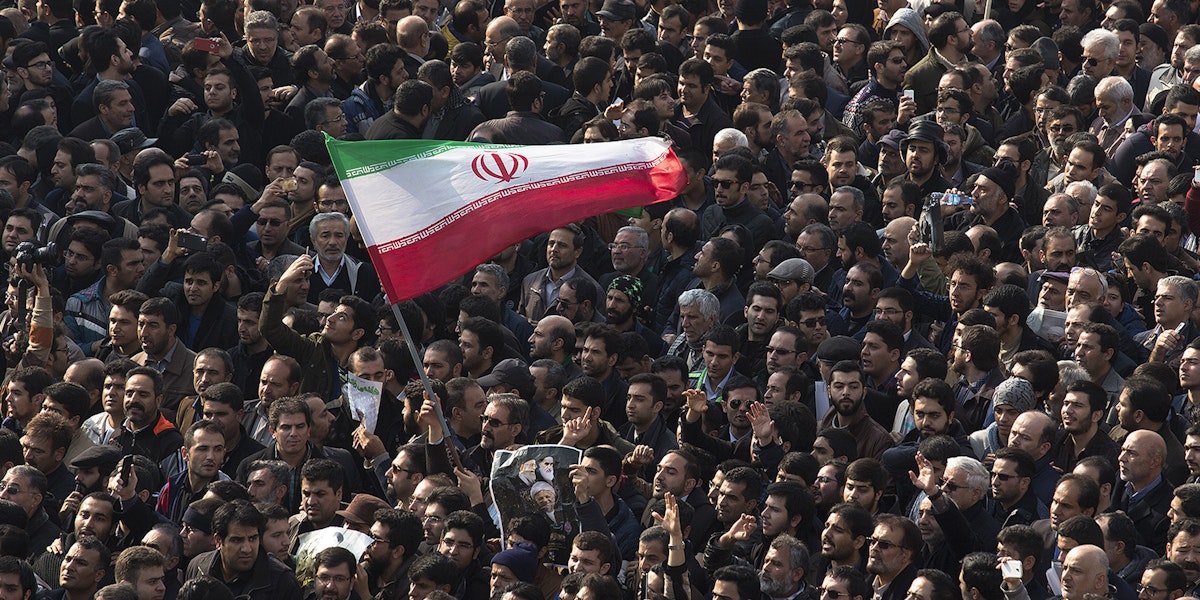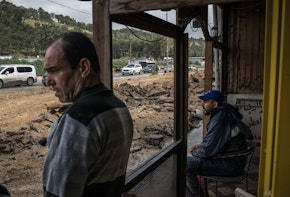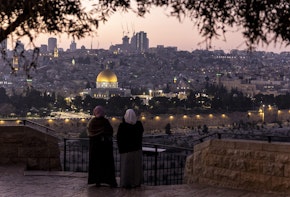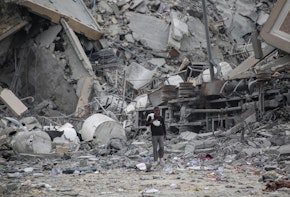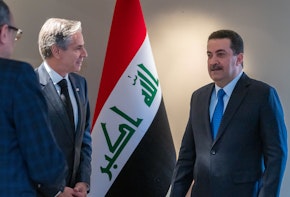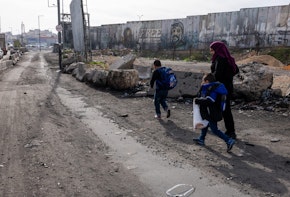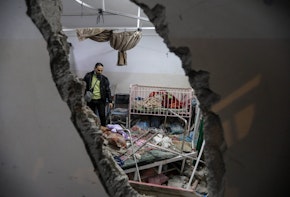It is by now clear that Donald Trump does not have an answer to one of the most bedeviling foreign policy problems of the last four decades: Iran. In this, he is not alone. Since the Islamic Republic’s founding in 1979, no American president has been able to figure out how best to manage the challenge that Tehran poses for stability and American interests in the Middle East.
But three years into the Trump administration’s erratic and aggressive Iran policy, Washington’s aims and strategy are more adrift than ever. Although it is uncertain whether Trump’s presidency will last another year or five—and whether a progressive administration will eventually succeed him—the time is ripe for the United States to develop an intentional, coherent, and effective policy toward Iran. American voters of different political stripes are raising fundamental questions about their role in the world—about U.S. core interests and priorities in a changing global order—creating an unprecedented opportunity to rethink U.S. foreign policy, especially in the Middle East. When the time comes, a new plan with a strong foundation will be needed.
The principles of de-escalation, diplomacy, and containment should guide U.S. policy toward Iran going forward. The 2015 nuclear deal with Iran (the Joint Comprehensive Plan of Action, or JCPOA) would have provided an ideal springboard for such a policy. But Trump has withdrawn from that agreement, and rejoining will not be possible. If the deal collapses entirely, Washington will have to rebuild trust in order to start new, broad negotiations; dial down conflict points; and find less risky ways to challenge and contain Iran. To this end, the United States’ first step must be to accept that, while Iran is a problematic actor, Washington has only a limited capacity to control its behavior. Second, the United States must compartmentalize regional and foreign policy as it relates to Iran. Iran cannot continue to be the lens through which Washington evaluates relationships with every other country in the region, or its basis for responding to every crisis. Third, the United States must right-size the perception of the Iranian threat—and manage political expectations about the possibility of reducing it. Fourth, the U.S. government must decide how best to engage Iran in diplomacy, and what format this engagement should take.
In the formulation of a new Iran policy, taking lessons from the past will be important. Barack Obama’s policy of engagement held promise, especially the nuclear deal. Importantly, the JCPOA successfully mitigated the possibility that Iran could pursue nuclear weapons. The agreement thus put a tangible constraint on one aspect of Iran’s most threatening behavior, and avoided further U.S.–Iran tension over Obama’s most serious Iran policy priority. Further, the JCPOA created a framework to negotiate on other important matters, including Iran’s missile program and involvement in regional wars.
Obama’s diplomatic engagement came with its own controversies, however. It didn’t slow down Tehran’s regional meddling, whether in Syria, Lebanon, Yemen, or elsewhere. Opponents of the JCPOA also argued that Iran accelerated its missile program while Washington was focused on negotiating the nuclear deal.1
More than likely, though, the JCPOA would have yielded additional positive results down the road. We will never know. Worse still, the Trump administration’s post-withdrawal campaign, which it dubbed “maximum pressure,” has only emboldened Iran. Tehran has increased its military activity, raised its political demands on partners, and begun to downgrade its implementation of the nuclear deal (which is supposed to remain in force for the remaining members, but is critically weakened without the United States).
The Trump administration’s “maximum pressure” campaign has only emboldened Iran.
Still, new policy must go further than a repudiation of Trump’s failures. Through both the Trump and Obama administrations—and indeed those of all the other presidencies since 1979—there has been a lack of reasonable and balanced assessments of the true threat that Iran poses to the United States and its interests. In some ways, the chaos of the Trump presidency has opened a door to reevaluate old assumptions, and to reconsider the goals for Iran and the Middle East that Washington’s strategists and politicians have long taken for granted.
Barriers to Dialogue with Iran
The basis for formulating a new approach to Iran must be a clear-eyed assessment of the challenges that Iran poses—and the ways that past American policy has failed to meet those challenges or evolve with them. One of the biggest barriers to Washington’s dialogue with Iran is mutual lack of trust, which dates to the founding of the Islamic Republic.
Following the Iranian Revolution in 1979, anti-Americanism became one of the main tenets of the new regime. Washington, for its part, was scarred by the 444-day hostage crisis, during which a group of Iranian students and revolutionaries detained fifty-two Americans in the U.S. embassy in Tehran.2 This watershed moment traumatized the minds of Americans and their officials alike. It also affected officials of the Islamic Republic, some of whom later regretted the hostage taking, believing it has since “colored relations between the two countries.”3
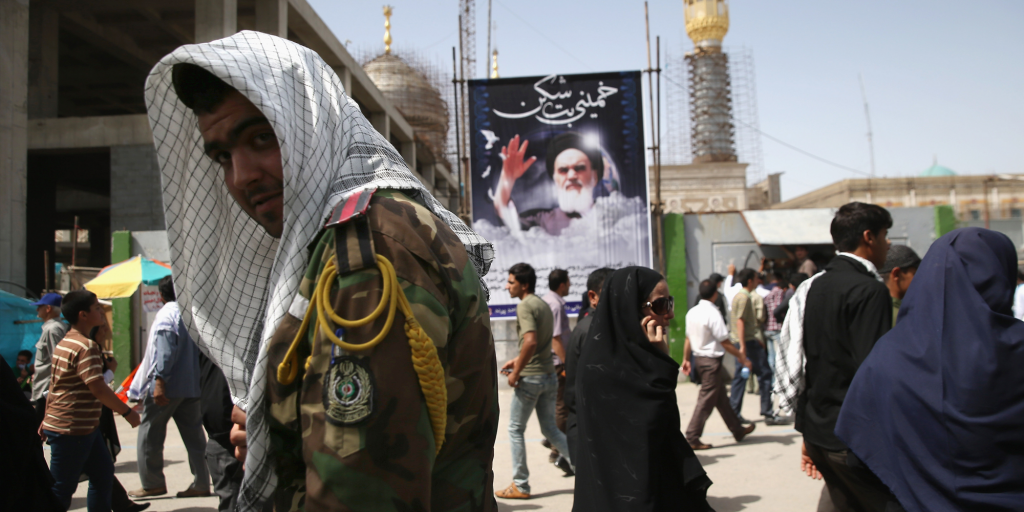
This history of mistrust made the 2015 JCPOA agreement, between Iran and the P5+1 (the five permanent members of the UN Security Council plus Germany), all the more significant. The nuclear deal not only resolves a long-standing international concern, but was also the culmination of years of dialogue, which only came to fruition when the United States engaged Iran directly. But, as mentioned above, the nuclear deal had its limitations: while it ensured that the United States and Iran could engage and compromise on one important matter of substance, the nuclear talks did not curb or counter Iran in the region. Candidate Trump made it clear that, as president, he would not hesitate to pull the United States out of the deal, and he did exactly that in May 2018. As a result, American credibility, reliability, and reputation as a state party to an international agreement has taken a real hit. The argument goes: why negotiate and make deals with the United States if subsequent administrations can then choose to ignore them—and seek to punish allies simply for upholding their end of the agreement?
American credibility, reliability, and reputation as a state party to an international agreement has taken a real hit.
The problems created by the withdrawal, however, go beyond damage to American credibility and reliability. The increased partisan nature of U.S. politics has become brutally apparent to Iranians. Iranian officials now believe that it is futile to negotiate with a Democratic administration, because a later Republican administration will likely overturn its decisions. To them, engagements taken on by a Republican administration are more likely to last and be respected by subsequent administrations. This effectively means that Iranians are less likely to engage with a Democratic president than they are with a Republican.
In addition, today, as a result of Trump’s “maximum pressure” campaign, Iran and the United States are locked in a spiral of escalating tensions with little or no off-ramp. The lack of direct communication between the two governments means that there are more serious risks of escalation following a miscommunication or misperception. The campaign has also led to a hardening of Iranian positions vis-à-vis Washington: the domestic political cost of negotiating with the United States for an Iranian official is too high, especially after the assassination of Qassem Soleimani—a high-level and popular Iranian official.4 Many Iranians do not condone what Soleimani did, and those who protested against the regime in November 2019 have not forgotten their discontent. But the threat from an external enemy has brought them together, at least momentarily, in a show of unity.
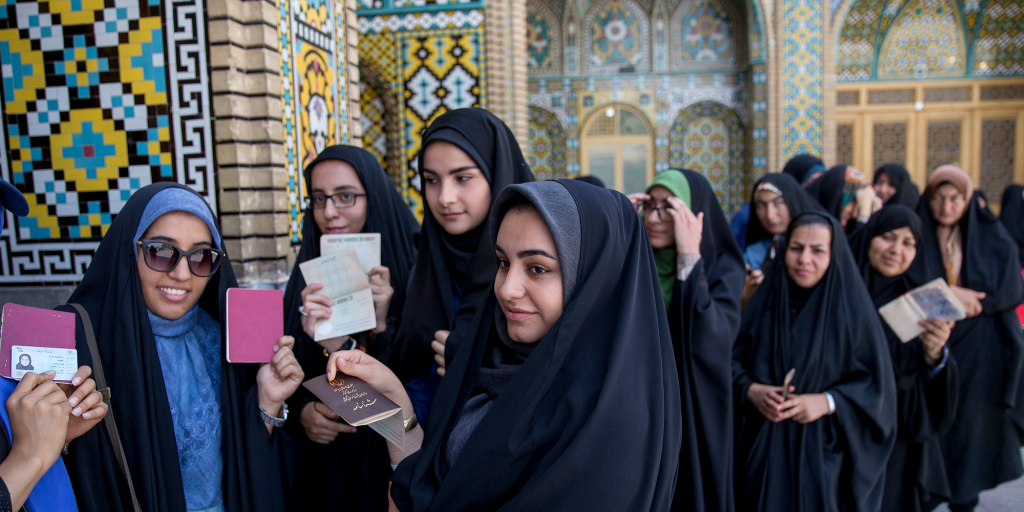
The persistent problem when assessing U.S.–Iran relations is that anti-Americanism is endemic to the political and security leadership of the Islamic Republic under the current supreme leader, and being anti-Iran is endemic to the American political sphere (and arguably so for both major political parties). Because of these dynamics, many influential decision-makers in the United Kingdom, for example, believe that a new deal is “inconceivable until [Iranian supreme leader Ali] Khamenei dies,” according to a recent research paper that polled officials and analysts.5 In the short term, the political climate in both Iran and the United States will make it difficult for either side to compromise. The United States is in full election mode, and after parliamentary elections in February 2020, Iran will hold presidential elections in 2021. These elections will happen at a turbulent time for the Islamic Republic, following the nationwide protests in November 2019, which it brutally suppressed, and the show of unity that followed Soleimani’s assassination. The current environment, as well as the Iranian Guardian Council’s disqualifying of thousands of moderate candidates from the parliamentary elections, suggest that the Iranian government is likely to become yet more conservative.6 The greater alignment between factions in Iran’s political system, which Trump’s “maximum pressure” campaign has partly caused, could make it easier to build a consensus in favor of a new deal. However, conservatives in Iran are tougher negotiators and less likely to compromise—in other words, the new Iranian consensus may be for an even more hard-line position.
American Priorities in the Region
The United States has not clearly articulated what its policy objectives are for Iran: To contain it? To change the current government? To integrate it into international relations in order to moderate its behavior? Each successive U.S. presidency has focused on one or a combination of the above. But American objectives for Iran, and the wider Middle East, have hit a wall, because events in the region have often overtaken decisions and affected which policy options are available.
The United States must build internal consensus on what it wants from Iran and the region. In other words, it should carefully consider and revise its “list of grievances.” American priorities in the Middle East have included counterterrorism, stability, Israel’s security, and energy security—though the latter is becoming somewhat less important.7 Ideally, the United States should also prioritize fostering the establishment of good governance in the region. But the American government and voters are tired of their country’s decades of risky and costly involvement in the Middle East. Expensive ventures and considerable policy failures have done little to effectively secure the United States.8 Washington must decide how much it can and wants to continue to contribute to regional security.
Iran policy can only be determined in the context of a wider Middle East strategy, which should promote regional peace and stability; de-emphasize military means of promoting American interests; and seek to de-escalate abusive governance and militarism by regional governments, whether allied or opposed to the United States.
American priorities in Iran should include the release of dual nationals, the respect of human rights, and containing Tehran’s proxies, partners, and allied hybrid actors, such as Hezbollah.
With regard to Iran, Washington should also be clearer about its aims. These will include the release of dual nationals currently detained in Iran, the respect of human rights in Iran, and containing Tehran’s proxies, partners, and allied hybrid actors, such as Hezbollah. The United States should perhaps even explore cooperation with Iran in specific, limited areas, such as in Iraq and Afghanistan. But Washington must ensure these goals are achievable: issuing a twelve-point plan that is tantamount to calling for Iran to utterly capitulate to the United States—as U.S. secretary of state Michael Pompeo did in May 2018—will only make dialogue and the pursuit of these goals more difficult.9 Such an approach simply entrenches Iranian positions.
Accepting Limits
The first and most important component of a new U.S. policy on Iran is to understand that Iran is a threat that can be managed, but not eradicated. Washington can try to balance Tehran, contain it, discourage bad behavior, and encourage better behavior, but it must also accept that it has a limited ability to control Tehran. Further, Iran will continue to be an important regional player. The United States also cannot forcibly prevent Iran from seeking a nuclear weapon or running militias in the region, if that is what Tehran is set on doing—no amount of brute force will remove Iranian knowledge of the nuclear program or erase intent, for example. However, the United States can deal with Iran in such a way as to secure incremental gains for American interests in the Middle East. Washington’s ability to coerce Iran is limited, but it can persuade or induce Iran to adopt certain policies.
As such, Washington should treat Iran as a problematic actor, whose behavior it cannot control or change by force. Expectations on what the United States can achieve with Iran must be lowered. It is crucial to understand that even if one problem area is resolved or managed, the United States will always have areas of contention with the Islamic Republic. The United States must manage the Iranian “problem,” while publicly stating what aspects of its behavior it finds most problematic, so that Washington is able to maintain the moral high ground as it navigates the complicated and difficult field of Middle Eastern politics.
Part of accepting that not everything is within Washington’s control involves deciding, firstly, what the United States can and cannot abide in the region, and secondly, what it can and cannot abide with respect to Iran, specifically. A formal policy review by a new U.S. administration would help whittle American priorities down to a realistic and limited set. In addition to justified fears of Iranian nuclear capabilities and missile range, the United States could, for instance, seek to limit Iran’s ability to strike regional energy infrastructure. Washington could also accept shared influence in contested zones such as Yemen, Lebanon, and Iraq, rather than always seeking to dominate them. On the other hand, the U.S. government would have to grudgingly accept that Iran will continue to wield influence and counter American priorities through its proxies and partners in Iran’s near neighborhood, which includes current or former U.S. priority areas such as the Arabian Peninsula, Iraq, Afghanistan, and the Levant. A meaningful prioritization would allow the United States a better chance to politically manage Iran: work with it when it serves American interests, but at the same time contain Tehran and its influence.
The United States has ample experience dealing with problematic countries whose policies it cannot simply ignore. For example, Turkey frequently operates counter to American interests even though it is a NATO treaty ally; China and Russia sometimes undermine and sometimes directly resist U.S. policy in the region, but are far more powerful than Iran and intersect with U.S. interests—sometimes productively—on a global scale, rather than regionally. None of these examples is an exact parallel to Iran, but each provides lessons from which Washington can draw.
In sum, the United States must establish realistic priorities, and then manage domestic political expectations about what can be achieved. Concretely, this would involve making some difficult decisions that many in the U.S. system will struggle with. For example, the United States will have to accept that Hezbollah and its link with Tehran are intractable problems. The Islamic Republic’s relationship with Hezbollah is one that Tehran will not give up—there is no scenario in which this is something that Tehran will consider. Iran played a key role in setting up the group, and Hezbollah represents and symbolizes the scale of Tehran’s reach into the region.10 As a Tehran-based Iranian academic close to the government put it: “The link between Iran and Hezbollah is very close. It takes two to three weeks for the cabinet to see the supreme leader, but Hassan Nasrallah will be granted an audience faster and with more ease than [Iranian president Hassan] Rouhani.”11 Nasrallah’s access to Iranian leadership demonstrates the depth of Hezbollah’s ties to Iran.
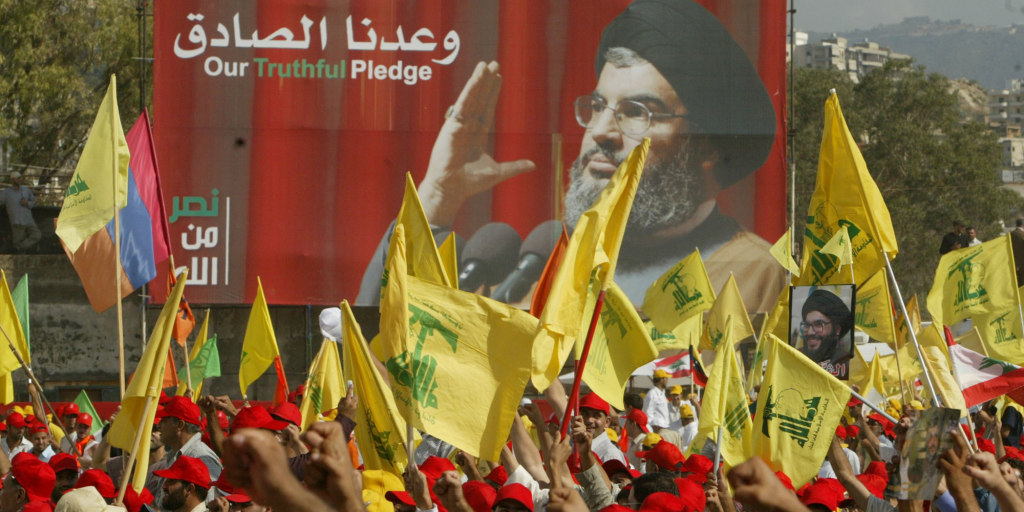
Washington’s insistence on imposing wide-ranging sanctions on Lebanese officials associated with Hezbollah, and its withholding of assistance to Lebanon because of Iran’s influence over the country (through Hezbollah), are counterproductive. These measures prevent American officials from engaging with a group that is problematic (to say the least), but nevertheless, a significant player in the Lebanese political scene. Like it or not, Washington must work with the fact that Hezbollah has evolved into a status quo movement operating largely within the framework of the Lebanese state.
The United States’ longtime designation of Hezbollah as a terrorist group is of similarly questionable expediency: the designation cuts off first-hand insight into the powerful militia-cum-political party. In addition, the designation prevents “deconfliction” (the term for avoidance of military engagement between two adversaries). Diplomatic contact with groups like Hezbollah would be integral to the de-escalation of tensions and crisis management. As it stands, the lack of communication that the terrorist designation requires makes it more likely that, say, a misunderstanding at the Lebanon–Israel border erupts into a major conflict. Washington doesn’t need to approve of or endorse troubling groups in order to accept that dealing with such groups might be practical.
In addition, Washington’s current stance on Hezbollah is problematic because it sets the breaking of ties between Tehran and Hezbollah as a precondition to meaningful dialogue with Iran. Since Tehran will not give up that relationship, this precondition only limits the United States’ flexibility in its foreign policy. This is not to say that a new approach will be easy to effect: changing Washington’s position on Hezbollah and Iran in this manner would represent a major shift, and require overcoming political and psychological blockages in place since 1979.
Parallel Policies for Iran and the Region
Today, Washington views every point of tension and crisis in the region in the context of the threat posed by Iran. From Yemen, to Iraq, to Syria, and Lebanon, all regional crises are viewed from the perspective of containing and rolling back Iranian influence, rather than as individual crises.
In effect, this prevents Washington from seeing crises in the region as having their own dynamics, causes, and solutions. This makes it more difficult for Washington to devise effective policies to contain or end these crises. In addition, policy options are inevitably limited by the outcome that the United States wants to avoid at all costs: helping Iran. Washington should not view the protests in Lebanon and Iraq primarily through the lens of its Iran policy, nor should it misinterpret popular anti-Iranian sentiment in those countries or elsewhere as an endorsement of either the United States or its hard-line policies against Iran.
Curbing corruption and encouraging good governance should be cornerstones of U.S. regional policy, irrespective of policies on Iran. Washington’s foot dragging in sending military assistance to the Lebanese Armed Forces (LAF) in the fall of 2019 is an example of this myopic approach. The Trump administration refused to release the Senate-approved aid for the LAF on the basis that the Lebanese military had been compromised by Hezbollah. The effect of the move may be quite the opposite of the intention: this funding is critical for Lebanon to contain other armed groups—namely, Hezbollah—by building the legitimate military.
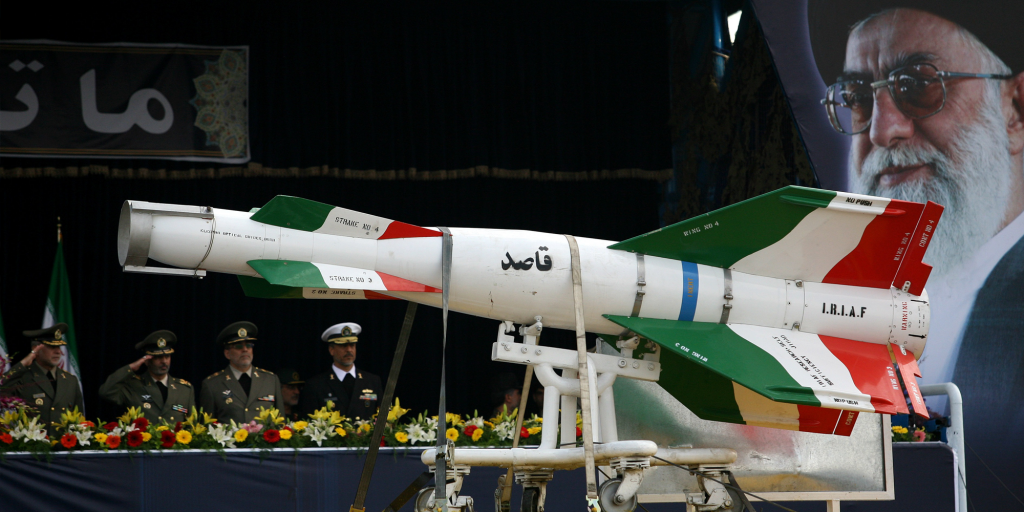
Compartmentalizing foreign policy should not be limited to delinking Iran from all regional crises and events. It is also advantageous for addressing the Iranian threat itself. Washington should differently pursue agreements, containment, and the foiling of Iran, depending on what is needed and what is possible in each situation. This approach will allow Washington to develop a flexible policy on Iran, giving it the opportunity to address Iran’s malign behavior and choices, while rewarding Iranian policy that is deemed helpful or good.
Such a shift in the American approach cannot be achieved until the domestic narrative in the United States changes. The United States must move away from painting Iran as the only serious threat in the region. This view of Iran as an existential threat abrogates the possibility of compromise. Instead, American policymakers must cultivate a new narrative, one that accurately paints Iran as a negative and nefarious actor in the region, but one that can be dealt with.
American policymakers must cultivate a new narrative, one that accurately paints Iran as a negative and nefarious actor in the region, but one that can be dealt with.
The Middle East cannot be viewed solely through the prism of containing Iran. Each conflict and crisis in the region has its own causes and solutions. While actively containing Iran may help certain situations, focusing on addressing crises individually and with the goal of improving governance in the region will likely also have the beneficial collateral impact of containing Iran. If the United States is better able to manage regional crises—hot wars, incompetent governance, the proliferation of armed actors strong enough to compete with or undermine the state—then the strategic environment will, overall, be more hospitable to American aims and less hospitable to Iran’s. Iran’s priorities thrive in contexts of poor governance, weak states, scarcity, and conflict.
An American policy that promotes accountability, opposes corruption, and reduces armed conflict will, over the long term, weaken Iran’s regional influence and agenda. It will also prevent Washington from taking steps that are counterproductive to the resolution of individual crises, or that may make the ground more fertile for growing Iranian influence.
Downsizing Threat Perception, Managing Expectations
The United States considers Iran a major threat, and an existential threat to its ally, Israel. Again, to be clear, it should be acknowledged that Iran is a troubling, destabilizing regional player, which foils regional and American interests in many ways. However, Iran is not an existential threat to the United States or to Israel. There is no foreseeable scenario in which Tehran is able to go to war with Israel directly and win, nor could it effectively threaten the U.S. homeland, other than by menacing American companies and infrastructure through cyber warfare. (And while this latter threat is real and significant, it is not one that Washington can directly confront or deter.) Iranian missiles do not yet possess the range to reach American soil.12 Washington could respond decisively to any threat of a missile attack against targets in the region, such as Israel—and Iran knows this. Tehran’s conventional capabilities are improving, but still limited, constrained by successive waves of sanctions and a blockade on the sale of weapons to the country. Iran does not want to find itself in a full-scale, conventional confrontation with the United States, because it knows it will lose.13
But while Tehran is no existential threat to the United States, it is a significant strategic nuisance to Washington and its assets and interests in the region in particular. This is the actual danger that Iran poses, and the United States must treat it as such, rather than magnifying a challenge that is costly and irritating into one that is a life-and-death struggle. It is imperative that Washington right-sizes the description of the threat posed by Iran, both in its official policy and in the narrative that it promotes to the American public.
The Format of Engagement
Washington must decide the format in which it wants to diplomatically engage Iran. There are various options, such as whether talks should be bilateral or multilateral, and led by the United States. In a U.S.-led, multilateral format, Washington would have ownership of the talks—but would thus also have ownership over failure or any stalling. Alternatively, there could be multilateral talks led by American partners such as the European Union; such a dialogue would be less controversial in Tehran. Yet another question is whether other regional actors should be involved. Normally, it would be safe to assume that the format most likely to yield an agreement would be a multilateral dialogue facilitated by the European governments who are parties to the JCPOA (Germany, France, and the United Kingdom). Those governments had credibility with both Washington and Tehran. But Iran’s experience with the JCPOA, and the Europeans’ inability to hold up their end of the bargain following American withdrawal, have made this difficult. While dialogue with the West continues to be attractive for some quarters of the Iranian elite, it may be best to focus on a regional dialogue, or a lower, expert-level and less formal bilateral dialogue between the United States and Iran, once both countries are ready to engage.
Regardless of the setting, the dialogue should focus on incremental confidence-building measures for issues like cooperation on drug trafficking, while simultaneously working on more significant (and more difficult) priorities, including, in particular, the nuclear file, missiles, and regional conflict. The regional arena may even offer avenues for cooperation, like the limited coordination and deconfliction that occurred between Tehran and Washington in the fight against the Islamic State in Iraq. The negotiations leading to the nuclear deal demonstrated that leaving out regional actors would allow them to act like spoilers in the implementation phase, because they did not feel ownership of the problem or its solution and, instead, feared the whole process. Equally, involving them risks bringing regional tensions into a U.S.–Iran dialogue.
All these questions should be debated and resolved in Washington. Any engagement with Iran will only succeed if it has bipartisan buy-in in the United States, and some kind of international backing.
Washington will also have to accept that its regional partners—particularly the Gulf Arab states—are likely to never be satisfied with the outcome and format of a U.S.–Iran dialogue.
It is likely that the most successful engagement of Iran is one that occurs on parallel tracks: on a higher, more official level for major crises, and on a low-level diplomatic or academic track for smaller problem areas, to sustain a general level of face time and engagement. This engagement will have to be conducted alongside regular dialogue, and at times, involvement of regional partners. But Washington will also have to accept that its regional partners—particularly the Gulf Arab states—are likely to never be satisfied with the outcome and format of a U.S.–Iran dialogue.
So far, the limited dialogue between Iran and the United States has been very much dependent on the personalities involved. Both sides were able to compromise during the nuclear negotiations in large part because of the trust that existed between the leading personalities that were party to the talks. Iranian foreign minister Mohammad Javad Zarif developed a relationship with U.S. secretary of state John Kerry, which was critical to achieving the nuclear deal. In addition, the relationship between the two allowed de-escalation in times of crisis: in January 2016, Iran detained American sailors, who were promptly released following a phone call between Kerry and Zarif.14
While this type of engagement is important in facilitating the prompt and smooth resolution of crises, it is problematic in that it ties engagement to the individuals involved. A change in the personalities involved can abruptly erase progress, and that is exactly what has happened with Trump, who has made it a point to disband any achievement of the Obama administration, dialogue with Iran included. Trump’s destruction of Obama’s progress shows how it is critical that engagement of Iran be depersonalized and made about national interests and security. Engagement must not become hostage to U.S. internal politics. As with effective diplomacy more broadly, this requires a routinization of diplomatic contacts that dispenses with an attitude that diplomatic engagement is a reward for positive behavior. With respect to Iran, routine contact requires a U.S. president willing to establish, as Obama did, an institutionalized state-to-state diplomatic process. This process could cut across sectors and involve multiple stakeholders so that it is not just beholden to the will of the two presidents or the foreign affairs officials in each country.
Crucially, any future agreement with Iran would only endure with bipartisan support in the United States. Treaties require approval from the U.S. Senate, which, in a polarized climate like today’s, means that meaningful international agreements like the JCPOA or the Paris Agreement (on climate change policy) aren’t even submitted for Senate approval and never achieve the status of law.15 Absent widespread support, future agreements with Iran can only be expected to last, in practice, as long as the term of the U.S. president who negotiates them—a dangerous scenario that limits the potential to stabilize the region and contain Iran.
Firm Principles for an Uncertain Future
The Islamic Republic of Iran is a significant foreign policy concern to Washington. The Trump administration’s exit from the 2015 nuclear deal and its “maximum pressure” campaign has made the future look bleak. Rather than building on the nuclear deal to engage Iran and curb its destabilizing activities, the Trump administration’s policies have pushed Iran to become more reckless in the region. Worryingly, Trump has pursued this track without any mechanism for de-escalation in place.
As such, the wind has been knocked out of the sails of the moderate movement in Iran. This weakening of the forces of moderation will likely lead to a hard-liner takeover of most of the state institutions, further increasing tensions with the United States. If the United States wants to manage this threat, then it will have to change the way it thinks about Iran.
The United States must first realistically define its objectives before formulating its policy approach. Promoting accountability, fighting corruption, and diminishing conflict will ultimately sap Iran’s regional leverage and agenda. A related effect of redefining objectives is that the United States will become more effective at resolving and preventing crises, making the region less receptive to Iranian influence in general.
Promoting accountability, fighting corruption, and diminishing conflict will ultimately sap Iran’s regional leverage and agenda.
Unless and until Washington establishes a more stable and less militarized posture across the region, American policy toward Iran will suffer from incoherence and a high risk of escalation. As long as tensions and open conflict flare in multiple countries in the Middle East and North Africa, the United States and Iran will have difficulty reaching an entente. But if the United States manages to develop a regional strategy that reduces conflict (between states as well as within them), then the relationship with Iran will enjoy some collateral boost.
Again, Iran is a threat that can be managed but cannot be eradicated. It is not an existential menace. The Iran threat must be downsized to reflect the actual dangers the country poses to Washington and its allies. Washington needs to realize that absolutist rhetoric and an irascible posture do little to help long-term goals on Iran. Having a flexible strategy in support of firm principles is far wiser. Only such an adaptable approach, which recognizes the limits of control over Iran, can succeed in containing Tehran, and coax it toward better behavior.
The contours of a U.S. policy reset on Iran are clear—even if the parameters depend on how much worse the crisis gets between now and the inauguration of a successor to Trump, whenever that happens.
Cover photo: Mourners attend the funeral of former Iranian president Ali Akbar Hashemi Rafsanjani in Tehran in January 2017. Rafsanjani, who was 82 when he died that month, was a pivotal figure in the foundation of the Islamic republic in 1979, and served as president from 1989 to 1997. Source: Majid Saeedi/Getty Images
Notes
- Reuel Marc Gerecht, “The Iran Deal is Strategically and Morally Absurd,” The Atlantic , May 4, 2018, https://www.theatlantic.com/international/archive/2018/05/iran-nuclear-deal-flawed/559595/; Mario Loyola, “Obama Should Never Have Appeased Iran,” The Atlantic, January 12, 2020, https://www.theatlantic.com/ideas/archive/2020/01/obama-should-never-have-appeased-iran/604744/.
- For more information on the hostage crisis, see David R Farber, Taken Hostage: The Iran Hostage Crisis and America’s First Encounter with Radical Islam (Princeton: Princeton University Press, 2005); Mark Bowden, Guests of the Ayatollah: The Hostage Crisis (New York: Grove Press, 2007).
- Iranian official, interview with the author, New York, September 2016.
- Dina Esfandiary, “By Killing Qassem Soleimani, Trump has Achieved the Impossible: Uniting Iran,” The Guardian, January 7, 2020, https://www.theguardian.com/commentisfree/2020/jan/07/qassem-suleimani-trump-uniting-iran-assassination-government. See also “Moving America Closer to War?,” a roundtable discussion hosted by The Century Foundation, January 8, 2020, https://tcf.org/content/report/roundtable-moving-america-closer-war/.
- Sanam Vakil and Neil Quilliam, “Getting to a New Iran Deal: A Guide for Trump, Washington, Tehran, Europe and the Middle East,” Chatham House, October 2019, p. 39, https://www.chathamhouse.org/publication/getting-new-iran-deal-guide-trump-washington-tehran-europe-and-middle-east.
- “Iran Disqualifies Thousands from Running for Parliament,” Associated Press, January 14, 2020, https://apnews.com/44ad5910fa3e1a297d6c0b5ad6c3c59f.
- See Willis L. Krumholz, “Petroleum Powerhouse: Why America No Longer ‘Needs’ the Middle East,” The National Interest, April 29, 2019,
https://nationalinterest.org/feature/petroleum-powerhouse-why-america-no-longer-needs-middle-east-55012; and Jeff D. Colgan, “Oil, Conflict, and U.S. National Interests,” Harvard Kennedy School Belfer Center for Science and International Affairs, October 2013, https://www.belfercenter.org/publication/oil-conflict-and-us-national-interests. - Martin Indyk, “The Middle East Isn’t Worth It Anymore,” Wall Street Journal, January 18, 2020, https://www.wsj.com/articles/the-middle-east-isnt-worth-it-anymore-11579277317.
- Michael Pompeo, “After the Deal: A New Iran Strategy,” speech, May 21, 2018, https://www.state.gov/after-the-deal-a-new-iran-strategy/
- Thanassis Cambanis, et al., Hybrid Actors: Armed Groups and State Fragmentation in the Middle East (New York: The Century Foundation, 2019), https://tcf.org/content/book/hybrid-actors-armed-groups-state-fragmentation-middle-east/.
- Ibid. p. 122–23.
- “Missiles of Iran,” Missile Defense Project, Center for Strategic and International Studies, June 14, 2018 (last modified January 22, 2020), https://missilethreat.csis.org/country/iran/.
- Iranian officials, interviews with the author, 2014–19.
- Hamid Dabashi, “The Personal Touch: Zarif, Kerry, and 10 US Sailors,” Al Jazeera, January 14, 2016, https://www.aljazeera.com/indepth/opinion/2016/01/personal-touch-zarif-kerry-10-sailors-160113073931498.html.
- See “Treaties: A Historical Overview,” U.S. Senate, https://www.senate.gov/artandhistory/history/common/briefing/Treaties.htm.
